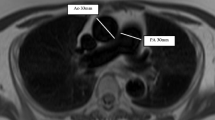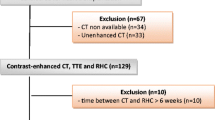Abstract
Objectives
To evaluate how pulmonary artery (PA) distensibility performs in detecting pulmonary hypertension due to left heart disease (PH-LHD) in comparison with parameters from ungated computed tomography (CT) and echocardiography.
Methods
One hundred patients (79 men, mean age = 63 ± 17 years) with either severe heart failure with reduced ejection fraction (HFrEF), aortic stenosis, or primary mitral regurgitation prospectively underwent right heart catheterization, ungated CT, ECG-gated CT, and echocardiography. During the ECG-gated CT, the right PA distensibility was calculated. In ungated CT, dPA, dPA/AA, the ratio of dPA to the diameter of the vertebra, segmental PA diameter, segmental PA-to-bronchus ratio, and the main PA volume were measured; the egg-and-banana sign was recorded. During echocardiography, the tricuspid regurgitation (TR) gradient was measured. The areas under the ROC curves (AUC) of these signs were computed and compared with DeLong test. Correlation between PA distensibility and PA pressure (PAP) was investigated through Pearson’s coefficient.
Results
PA distensibility was lower in patients with PH than in those without PH (11.4 vs. 21.2%, p < 0.001) and correlated negatively with mean PAP (r = − 0.72, p < 0.001). Age, PA size, and mean PAP were independent predictors of PA distensibility. PA distensibility < 18% detected PH-LHD with 96% sensitivity and 73% specificity; its AUC was 0.92, larger than that of any other sign at ungated CT and TR gradient (AUC ranging from 0.54 to 0.83, DeLong: p ranging from 0.020 to < 0.001).
Conclusion
PA distensibility on an ECG-gated CT can detect PH-LHD better than the parameters reflecting PA dilatation in ungated CT or TR gradient in the echocardiography of patients with severe HFrEF, aortic stenosis, or mitral regurgitation.
Key Points
• In left heart disease, pulmonary artery distensibility is lower in patients with PH than in those without pulmonary hypertension (11.4 vs. 21.2%, p < 0.001).
• In left heart disease, pulmonary artery distensibility detects pulmonary hypertension with an area under the receiver operating curve of 0.92.
• In left heart disease, the area under the receiver operating curve of pulmonary artery distensibility for detecting pulmonary hypertension is larger than that of all other signs at ungated CT (p from 0.019 to < 0.001) and tricuspid regurgitation gradient at echocardiography (p = 0.020).



Similar content being viewed by others
Abbreviations
- ABR:
-
Pulmonary artery to bronchus ratio
- AUC:
-
Area under the receiver operating characteristic curve
- dPA:
-
Diameter of the main pulmonary artery
- dPA/AA:
-
Diameter of the main pulmonary artery to the diameter of the ascending aorta ratio
- dPA/V:
-
Diameter of the main pulmonary artery to the diameter of the vertebral body ratio
- HFrEF:
-
Heart failure with reduced injection fraction
- PA:
-
Pulmonary artery
- PAP:
-
Pulmonary artery pressure
- PAWP:
-
Pulmonary artery wedge pressure
- PH:
-
Pulmonary hypertension
- PH-LDH:
-
Pulmonary hypertension due to left heart disease
- TR:
-
Tricuspid regurgitation
References
Galie N, Humbert M, Vachiery JL et al (2016) 2015 ESC/ERS guidelines for the diagnosis and treatment of pulmonary hypertension: the Joint Task Force for the Diagnosis and Treatment of Pulmonary Hypertension of the European Society of Cardiology (ESC) and the European Respiratory Society (ERS): endorsed by: Association for European Paediatric and Congenital Cardiology (AEPC), International Society for Heart and Lung Transplantation (ISHLT). Eur Heart J 37(1):67–119
Vachiery JL, Adir Y, Barbera JA et al (2013) Pulmonary hypertension due to left heart diseases. J Am Coll Cardiol 62(25 Suppl):D100–D108
Ghio S, Gavazzi A, Campana C et al (2001) Independent and additive prognostic value of right ventricular systolic function and pulmonary artery pressure in patients with chronic heart failure. J Am Coll Cardiol 37(1):183–188
Rosenkranz S, Gibbs JS, Wachter R, De Marco T, Vonk-Noordegraaf A, Vachiery JL (2016) Left ventricular heart failure and pulmonary hypertension. Eur Heart J 37(12):942–954
Janda S, Shahidi N, Gin K, Swiston J (2011) Diagnostic accuracy of echocardiography for pulmonary hypertension: a systematic review and meta-analysis. Heart 97(8):612–622
Kuriyama K, Gamsu G, Stern RG, Cann CE, Herfkens RJ, Brundage BH (1984) CT-determined pulmonary artery diameters in predicting pulmonary hypertension. Invest Radiol 19(1):16–22
Tan RT, Kuzo R, Goodman LR, Siegel R, Haasler GB, Presberg KW (1998) Utility of CT scan evaluation for predicting pulmonary hypertension in patients with parenchymal lung disease. Chest 113(5):1250–1256
Ng CS, Wells AU, Padley SP (1999) CT sign of chronic pulmonary arterial hypertension: the ratio of main pulmonary artery to aortic diameter. J Thorac Imaging 14(4):270–278
Chan AL, Juarez MM, Shelton DK, MacDonald T, Li CS, Lin TC, Albertson TE (2011) Novel computed tomographic chest metrics to detect pulmonary hypertension. BMC Med Imaging 11:7
Davarpanah AH, Hodnett PA, Farrelly CT et al (2011) MDCT bolus tracking data as an adjunct for predicting the diagnosis of pulmonary hypertension and concomitant right-heart failure. AJR Am J Roentgenol 197(5):1064–1072
Truong QA, Massaro JM, Rogers IS et al (2012) Reference values for normal pulmonary artery dimensions by noncontrast cardiac computed tomography: the Framingham Heart Study. Circ Cardiovasc Imaging 5(1):147–154
Eberhard M, Mastalerz M, Pavicevic J et al (2017) Value of CT signs and measurements as a predictor of pulmonary hypertension and mortality in symptomatic severe aortic valve stenosis. Int J Cardiovasc Imaging 33(10):1637–1651
Colin GC, Gerber BL, de Meester de Ravenstein C et al (2018) Pulmonary hypertension due to left heart disease: diagnostic and prognostic value of CT in chronic systolic heart failure. Eur Radiol 28(11):4643–4653
O’Sullivan CJ, Montalbetti M, Zbinden R et al (2018) Screening for pulmonary hypertension with multidetector computed tomography among patients with severe aortic stenosis undergoing transcatheter aortic valve implantation. Front Cardiovasc Med 5:63
Scelsi CL, Bates WB, Melenevsky YV, Sharma GK, Thomson NB, Keshavamurthy JH (2018) Egg-and-banana sign: a novel diagnostic CT marker for pulmonary hypertension. AJR Am J Roentgenol 210(6):1235–1239
Li M, Wang S, Lin W et al (2018) Cardiovascular parameters of chest CT scan in estimating pulmonary arterial pressure in patients with pulmonary hypertension. Clin Respir J 12(2):572–579
Devaraj A, Wells AU, Meister MG, Corte TJ, Wort SJ, Hansell DM (2010) Detection of pulmonary hypertension with multidetector CT and echocardiography alone and in combination. Radiology 254(2):609–616
Spruijt OA, Bogaard HJ, Heijmans MW et al (2015) Predicting pulmonary hypertension with standard computed tomography pulmonary angiography. Int J Cardiovasc Imaging 31(4):871–879
Rengier F, Wörz S, Melzig C et al (2016) Automated 3D volumetry of the pulmonary arteries based on magnetic resonance angiography has potential for predicting pulmonary hypertension. PLoS One 11(9):e016251
Melzig C, Wörz S, Egenlauf E et al (2019) Combined automated 3D volumetry by pulmonary CT angiography and echocardiography for detection of pulmonary hypertension. Eur Radiol 29(11):6059–6068
Revel MP, Faivre JB, Remy-Jardin M, Delannoy-Deken V, Duhamel A, Remy J (2009) Pulmonary hypertension: ECG-gated 64-section CT angiographic evaluation of new functional parameters as diagnostic criteria. Radiology 250(2):558–566
Ponikowski P, Voors AA, Anker SD et al (2016) 2016 ESC guidelines for the diagnosis and treatment of acute and chronic heart failure. Eur Heart J 27:2129–2200
Stamm G (2012) Collective radiation dose from MDCT: critical review of surveys studies. In: Tack D, Kalra MK, Gevenois PA (eds) Radiation dose from multidetector CT, 2nd edn. Springer-Verlag, Heidelberg, pp 209–229
Tji-Joong Gan C, Lankhaar JW, Westerhof N et al (2007) Noninvasively assessed pulmonary artery stiffness predicts mortality in pulmonary arterial hypertension. Chest 132(6):1906–1912
Sanz J, Kariisa M, Dellegrottaglie S et al (2009) Evaluation of pulmonary artery stiffness in pulmonary hypertension with cardiac magnetic resonance. JACC Cardiovasc Imaging 2(3):286–295
Sanz J, Kuschnir P, Rius T et al (2007) Pulmonary arterial hypertension: noninvasive detection with phase-contrast MR imaging. Radiology 243(1):70–79
Kasai H, Sugiura T, Tanabe N et al (2014) Electrocardiogram-gated 320-slice multidetector computed tomography for the measurement of pulmonary arterial distensibility in chronic thromboembolic pulmonary hypertension. PLoS One 9(11):e111563
Abel E, Jankowski A, Pison C, Luc Bosson J, Bouvaist H, Ferretti GR (2012) Pulmonary artery and right ventricle assessment in pulmonary hypertension: correlation between functional parameters of ECG-gated CT and right-side heart catheterization. Acta Radiol 53(7):720–727
Jardim C, Rochitte CE, Humbert M et al (2007) Pulmonary artery distensibility in pulmonary arterial hypertension: an MRI pilot study. Eur Respir J 29:476–481
Porter TR, Taylor DO, Fields J et al (1993) Direct in vivo evaluation of pulmonary arterial pathology in chronic congestive heart failure with catheter-based intravascular ultrasound imaging. Am J Cardiol 71:754–757
Andersen OS, Smiseth OA, Dokainish H et al (2017) Estimating left ventricular filling pressure by echocardiography. J Am Coll Cardiol 69(15):1937–1948
Funding
The authors state that this work has not received any funding.
Author information
Authors and Affiliations
Corresponding author
Ethics declarations
Guarantor
The scientific guarantor of this publication is Dr. Geoffrey C Colin.
Conflict of interest
The authors of this manuscript declare no relationships with any companies, whose products or services may be related to the subject matter of the article.
Statistics and biometry
No complex statistical methods were necessary for this paper.
Informed consent
Written informed consent was obtained from all subjects (patients) in this study.
Ethical approval
Institutional Review Board approval was obtained.
Methodology
• prospective
• diagnostic or prognostic study
• performed at one institution
Additional information
Publisher’s note
Springer Nature remains neutral with regard to jurisdictional claims in published maps and institutional affiliations.
Rights and permissions
About this article
Cite this article
Colin, G.C., Verlynde, G., Pouleur, AC. et al. Pulmonary hypertension due to left heart disease: diagnostic value of pulmonary artery distensibility. Eur Radiol 30, 6204–6212 (2020). https://doi.org/10.1007/s00330-020-06959-7
Received:
Revised:
Accepted:
Published:
Issue Date:
DOI: https://doi.org/10.1007/s00330-020-06959-7




